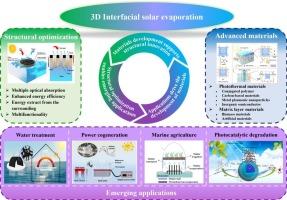A comprehensive review on 3D interfacial solar evaporation for sustainable desalination and integrated energy management: structural optimization strategies, advanced materials, and emerging applications
IF 11
1区 工程技术
Q1 ENERGY & FUELS
引用次数: 0
Abstract
Interfacial solar evaporation (ISE) has become a key solution to address global water scarcity by providing an energy-efficient method for water purification. Initially developed as simple double-layered two-dimensional (2D) evaporators, their limited evaporation rates and functionalities spurred the evolution toward three-dimensional (3D) evaporators. This transition marked a transformative shift in the field, where 3D structures not only overcame the theoretical constraints of 2D systems but also introduced novel functionalities through their intricate designs. Although numerous 3D interfacial solar evaporators have been proposed, a comprehensive review of the key advancements in the optimization strategy and application prospect is still lacking. In this review, we systematically examine and summarize advances in 3D evaporators, focusing on rational structural design optimization governing light-water-heat-energy nexus, application of advanced materials in 3D ISE, and derivative functions expanding applications beyond desalination, including salt crystal collection and cogeneration. Challenges and future research prospects are proposed, emphasizing the issues in 3D evaporator development and future research priorities. This review will be helpful for the researches in improving equipment efficiency and coming up with a sustainable desalination and wastewater treatment.

三维界面太阳能蒸发用于可持续海水淡化和综合能源管理:结构优化策略,先进材料和新兴应用综述
界面太阳能蒸发(ISE)通过提供一种节能的水净化方法,已成为解决全球水资源短缺的关键解决方案。最初发展为简单的双层二维(2D)蒸发器,其有限的蒸发速率和功能刺激了向三维(3D)蒸发器的发展。这一转变标志着该领域的革命性转变,3D结构不仅克服了2D系统的理论限制,而且通过其复杂的设计引入了新的功能。虽然已经提出了许多三维界面太阳能蒸发器,但对其优化策略和应用前景的关键进展仍缺乏全面的综述。在这篇综述中,我们系统地研究和总结了3D蒸发器的进展,重点是控制光-水-热-能关系的合理结构设计优化,先进材料在3D ISE中的应用,以及扩展海水淡化以外应用的衍生函数,包括盐晶体收集和热电联产。提出了面临的挑战和未来的研究展望,强调了三维蒸发器发展中存在的问题和未来的研究重点。本文的研究将有助于提高设备效率,提出可持续的海水淡化和废水处理方法。
本文章由计算机程序翻译,如有差异,请以英文原文为准。
求助全文
约1分钟内获得全文
求助全文
来源期刊

Applied Energy
工程技术-工程:化工
CiteScore
21.20
自引率
10.70%
发文量
1830
审稿时长
41 days
期刊介绍:
Applied Energy serves as a platform for sharing innovations, research, development, and demonstrations in energy conversion, conservation, and sustainable energy systems. The journal covers topics such as optimal energy resource use, environmental pollutant mitigation, and energy process analysis. It welcomes original papers, review articles, technical notes, and letters to the editor. Authors are encouraged to submit manuscripts that bridge the gap between research, development, and implementation. The journal addresses a wide spectrum of topics, including fossil and renewable energy technologies, energy economics, and environmental impacts. Applied Energy also explores modeling and forecasting, conservation strategies, and the social and economic implications of energy policies, including climate change mitigation. It is complemented by the open-access journal Advances in Applied Energy.
 求助内容:
求助内容: 应助结果提醒方式:
应助结果提醒方式:


